Roller skating
Roller skating is the traveling on surfaces with roller skates. It is a form of recreational activity as well as a sport, and can also be a form of transportation. In fact, as the United States readied for World War II, the government entertained the notion to add roller skates as essential equipment to move infantry around Europe to save gas. Skates generally come in three basic varieties: quad roller skates, inline skates or blades and tri-skates, though some have experimented with a single-wheeled "quintessence skate" or other variations on the basic skate design. In America, this hobby was most popular first between 1935 and the early 1960s and then in the 1970s, when polyurethane wheels were created and disco music oriented roller rinks were the rage and then again in the 1990s when in-line outdoor roller skating, thanks to the improvement made to inline roller skates in 1981 by Scott Olson, took hold.
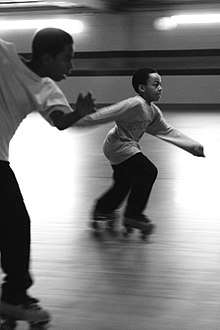
History
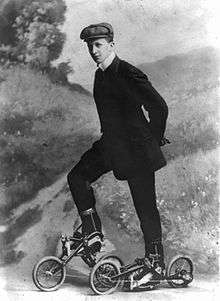
Roller skating has had a checkered past over its nearly-three century history. Given its ebb and flow of popularity over the past century, writers labeled each generation's attraction a "craze!" The caption in a 1904 Decatur newspaper read, "Old Craze Comes Back," adding, "Roller skating promises to be as popular as it was twenty years ago." Reported on 11 October 1904, the statement announced the opening events of a new Decatur, Illinois roller rink.[2] In 1906, with the opening of another Chicago rink, the Inter Ocean newspaper complained that "after twenty years of exemption from the affliction the desire to roll is again taking possession of American adults...the mania has struck Chicago!"[3]
Nearly forty years later, Charlie Tyler would write, "This current roller skating 'craze' is nothing new." Tyler wrote for Chicago's Herald-American in September 1941 and described the opening of Chicago's Madison Gardens Rink's thirty-fifth season on the eve of World War II.[4] Tyler was referring to the first roller skate craze at the turn of the twentieth century,[5] when ball bearings revolutionized roller technology and roller skaters staged spectacle events and speed-skating marathons. Clamp-on skates were mass-produced for those with great aspirations. Tyler's reporting attempted to temper the rebirth of enthusiasm for the new roller styles that had become popular, including roller derby and dancing on rollers, suggesting that we had seen this before.
Today, the acceptance for roller skating is not unlike a waning moon but the sport persists. Roller skating continues to thrive as a part of pop culture in the form of recreation for leisure, dance and sport. Rollers, past and present are diehards.[6]
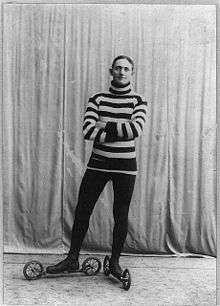
- 1743: First recorded use of roller skates, in a London stage performance. The inventor of this skate is unknown.
- 1760: First recorded skate invention, by John Joseph Merlin, who created a primitive inline skate with small metal wheels.
- 1818: Roller skates appeared on the ballet stage in Berlin.[7]
- 1819: First patented roller skate design, in France by M. Petitbled. These early skates were similar to today's inline skates, but they were not very maneuverable. It was difficult with these skates to do anything but move in a straight line and perhaps make wide sweeping turns.
- Rest of the 19th century: inventors continued to work on improving skate design.
- 1823: Robert John Tyers of London patented a skate called the Rolito. This skate had five wheels in a single row on the bottom of a shoe or boot.[8]
- 1857: Finally, roller skating had gained enough momentum to warrant the opening of the first public skating rinks. The Strand, London and Floral Hall had these first roller rinks.[9]
- 1863: The four-wheeled turning roller skate, or quad skate, with four wheels set in two side-by-side pairs (front and rear), was first designed, in New York City by James Leonard Plimpton in an attempt to improve upon previous designs. The skate contained a pivoting action using a rubber cushion that allowed the skater to skate a curve just by pressing his weight to one side or the other, most commonly by leaning to one side. It was a huge success, so much so that the first public roller skating rinks were opened in 1866, first in New York City by Plimpton in his furniture store and then in Newport, Rhode Island with the support of Plimpton. The design of the quad skate allowed easier turns and maneuverability, and the quad skate came to dominate the industry for more than a century.
- 1875 Roller skating rink in Plymouth, England held its first competition.[10]
- 1876: William Brown in Birmingham, England, patented a design for the wheels of roller skates. Brown's design embodied his effort to keep the two bearing surfaces of an axle, fixed and moving, apart. Brown worked closely with Joseph Henry Hughes, who drew up the patent for a ball or roller bearing race for bicycle and carriage wheels in 1877. Hughes' patent included all the elements of an adjustable system. These two men are thus responsible for modern roller skate and skateboard wheels, as well as the ball bearing race inclusion in velocipedes—later to become motorbikes and automobiles. This was arguably the most important advance in the realistic use of roller skates as a pleasurable pastime.
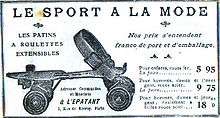
- 1876: The toe stop was first patented. This provided skaters with the ability to stop promptly upon tipping the skate onto the toe. Toe stops are still used today on most quad skates and on some types of inline skates.
- 1877: The Royal Skating indoor skating ring building is erected rue Veydt, Brussels.[11]
- 1880s: Roller skates were being mass-produced in America from then. This was the sport's first of several boom periods. Micajah C. Henley of Richmond, Indiana produced thousands of skates every week during peak sales. Henley skates were the first skate with adjustable tension via a screw, the ancestor of the kingbolt mechanism on modern quad skates.
- 1884: Levant M. Richardson received a patent for the use of steel ball bearings in skate wheels to reduce friction, allowing skaters to increase speed with minimum effort.
- 1898: Richardson started the Richardson Ball Bearing and Skate Company, which provided skates to most professional skate racers of the time, including Harley Davidson (no relation to the Harley-Davidson motorcycle brand). (Turner and Zaidman, 1997).
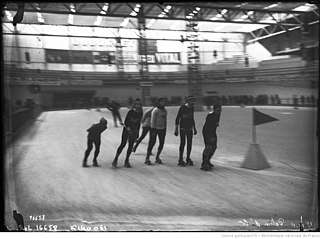
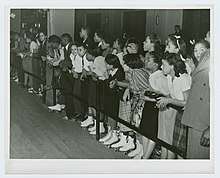
- The design of the quad skate has remained essentially unchanged since then, and remained as the dominant roller skate design until nearly the end of the 20th century. The quad skate has begun to make a comeback recently due to the popularity of roller derby and jam skating.
- 1900: The Peck & Snyder Company patented an inline skate with two wheels.[12]
- 1902: The Chicago Coliseum opened a public skating rink. Over 7,000 people attended the opening night.[8]
- 1935: The Chicago Coliseum hosts the first Transcontinental Roller Derby with a pair of men and women and Chicago becomes the birthplace of roller derby.[6]
- 1937: Roller skating the sport was organized nationally by the Roller Skate Rink Owner's Association and the onset of roller skating's golden age[13]
- 1977: Inline skates looking like ice skates were used by DEFA, the East German state film studio, in the film "Die zertanzten Schuhe", based on the fairy tale The Twelve Dancing Princesses, in some winter scenes on a frozen lake.
- 1979: Scott Olson and Brennan Olson of Minneapolis, Minnesota came across a pair of inline skates created in the 1960s by the Chicago Roller Skate Company and, seeing the potential for off-ice hockey training, set about redesigning the skates using modern materials and attaching ice hockey boots. A few years later Scott Olson began heavily promoting the skates and launched the company Rollerblade, Inc..
- 1983 President Ronald Reagan declared October National Roller Skating Month.
- 1993 - Active Brake Technology, Rollerblade, Inc. developed ABT or Active Brake Technology for increased safety.[14]
During the late 1980s and early 1990s, the Rollerblade-branded skates became so successful that they inspired many other companies to create similar inline skates, and the inline design became more popular than the traditional quads. The Rollerblade skates became synonymous in the minds of many with "inline skates" and skating, so much so that many people came to call any form of skating "Rollerblading," thus making it a genericized trademark.
For much of the 1980s and into the 1990s, inline skate models typically sold for general public use employed a hard plastic boot, similar to ski boots. In or about 1995, "soft boot" designs were introduced to the market, primarily by the sporting goods firm K2 Inc., and promoted for use as fitness skates. Other companies quickly followed, and by the early 2000s the development of hard shell skates and skeletons became primarily limited to the Aggressive inline skating discipline and other specialized designs.
The single-wheel "quintessence skate"[15] was made in 1988 by Miyshael F. Gailson of Caples Lake Resort, California, for the purpose of cross-country skate skiing and telemark skiing training. Other experimental skate designs the years have included two wheeled (heel and toe) inline skate frames but the vast majority of skates on the market today are either quad or standard inline design.
Artistic roller skating
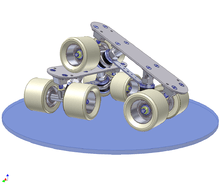
Artistic roller skating is a sport which consists of a number of events. These are usually accomplished on quad skates, but inline skates may be used for some events. Various flights of events are organized by age and ability/experience. In the US, local competitions lead to 9 regional competitions which led to the National Championships and World Championships.
Figures
A prescribed movement symmetrically composed of at least two circles, but not more than three circles, involving primary, or primary and secondary movements, with or without turns. Figures are skated on circles, which have been inscribed on the skating surface.[16][17]
Dance
In competition skaters can enter more than one event;
Solo Dance; solo dance a competition starts at tiny tot and goes up to golden, for a test it starts with bronze and goes up to gold. You do not have to take tests anymore to skate in harder categories, you must have a couple of tests once you get to a certain event, though. In competition, these dances are set patterns and the judges give you marks for good edges, how neat they look and how well they do turns, etc.
Team Dance; this is where two people skate together doing the set dances. Most people skate with a partner the same ability and age.
Skaters are judged by the accuracy of steps that they skate when performing a particular dance. In addition to being judged on their edges and turns, skaters must carry themselves in an elegant manner while paying careful attention to the rhythm and timing of the music.
Freestyle
Freestyle roller dancing is a style of physical movement, usually done to music, that is not choreographed or planned ahead of time. It occurs in many genres, including those where people dance with partners. By definition, this kind of dance is never the same from performance to performance, although it can be done formally and informally, sometimes using some sparse choreography as a very loose outline for the improvisation.
Precision teams
A team of skaters (usually counted in multiples of four) creates various patterns and movements to music. Often used elements include skating in a line, skating in a box, "splicing" (subgroups skating towards each other such that they do not contact each other), and skating in a circle. The team is judged on its choreography and the ability to skate together precisely, and jumps and spins are not as important. In this category, they are classified as "small groups" (6 to 15 people) or "big groups" (16 to 30 skaters). These show groups are also divided due to the level and ages.
Singles and pairs
A single skater or a pair of skaters present routines to music. They are judged on skating ability and creativity. Jumps, spins and turns are expected in these events. Sometimes with a pair or couple skaters slow music will play, and usually it is two songs.
Speed skating
Speed skating originally started on traditional roller skates, quads or four wheels per skate. The first organized, national competition was held in 1938 in Detroit Michigan at the Arena Gardens Roller Rink, once home of "Detroit's Premier Sports Palace. The Arena opened in 1935 as roller skating began its ascension as a top sport.[6] In the early years, competitors representing the mid-west states, primarily Illinois, Indiana, Michigan and Ohio dominated the sport. By 1950 as rinks hired speed skating coaches who trained competitors, the east and west coast began to compete effectively for the national titles. But in the early years, national titles were dominated by Chicago, Detroit, Cleveland and Cincinnati.
As rules were established for state and national competitions, the speed skating season began in fall and continued through spring leading up to a state tournament. Eventually approximately 1947, due to the growth of speed skating, the top three places at a state tournament would qualify skaters for a regional tournament. The top three places at regional tournaments then went on to compete at a national tournament. Skaters could qualify as individuals or as part of a two-person or four-person (relay) team. Qualification at regional events could warrant an invite to the Olympic Training Center in Colorado Springs, CO for a one-week training session on their outdoor velodrome. Inline speed skating is a competitive non-contact sport on inline skates. Variants include indoor, track and road racing, with many different grades of skaters, so the whole family can compete.
Group skating
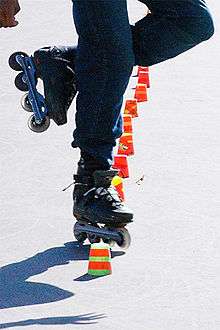
Among skaters not committed to a particular discipline, a popular social activity is the group skate or street skate, in which large groups of skaters regularly meet to skate together, usually on city streets. One such group is the San Francisco Midnight Rollers. In 1989 the small 15-20 group that became the Midnight Rollers explored the closed doubIe-decker Embarcadero Freeway after the Loma-Prieta earthquake until it was torn down.[18] At which point the new route was created settling on Friday nights at 9 pm from the San Francisco Ferry Building circling 12 miles around the city back at midnight to the start.[19][20][21][22] Although such touring existed among quad roller skate clubs in the 1970s and 1980s, it made the jump to inline skates in 1990 with groups in large cities throughout the United States. In some cases, hundreds of skaters would regularly participate, resembling a rolling party. In the late 1990s, the group skate phenomenon spread to Europe and east Asia. The weekly Friday night skate in Paris, France (called Pari Roller[23]) is believed to be one of the largest repeating group skates in the world. At times, it has had as many as 35,000 skaters participating on the boulevards of Paris, on a single night. The Sunday Skate Night in Berlin also attracts over 10,000 skaters during the summer, and Copenhagen, Munich, Frankfurt, Amsterdam, Buenos Aires, London, San Francisco, Los Angeles, New York, and Tokyo host other popular events. Charity skates in Paris have attracted 50,000 participants (the yearly Paris-Versailles skate). The current Official Guinness World Record holder is Nightskating Warszawa (Poland) in number of 4013 participants from 19 June 2014, but their real record from 25 April 2015 is 7303 participants and over 38 000 skaters total in 10 events in season 2015.
Aggressive inline
Aggressive inline skating is trick-based skating. This is where the individual performs tricks using a slightly different skate to normal. The skate has a grind block in between two wheels and the various companies have designed the boots to take these extra strains. Also the wheels have a flat large contact surface for grip.
Aggressive inline can either take place at a skate park or on the street. Typically predominantly grinds but also air tricks such as spins and flips.
Roller hockey
Roller hockey is the overarching name for a rollersport that existed long before inline skates were invented, and thus has various names. Quad skate roller hockey has been played in many countries worldwide, and was a demonstration rollersport in the 1992 Summer Olympics in Barcelona. Other variations include skater hockey, played with a plastic ball, and inline hockey.
Skating federations
In the United States, the controlling organization is USA Roller Sports, headquartered in Lincoln, Nebraska, also home of the National Museum of Roller Skating.[24] Nationals are held each summer with skaters required to qualify through state and regional competitions.
Roller derby
Roller derby is a team sport played on roller skates on an oval track. Originally a trademarked product developed out of speed skating demonstrations, the sport underwent a revival in the early 2000s as a grass-roots-driven, five-a-side sport played mainly by women.[25] Most roller derby leagues adopt the rules and guidelines set by the Women's Flat Track Derby Association or its open gender counterpart, Men's Roller Derby Association, but there are leagues that play on a banked track, as the sport was originally played from the 1930s.
Aggressive roller skating
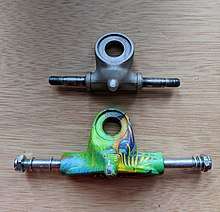
Otherwise known as "park skating", popularized by CIB (fka Chicks in Bowls[26]) and Moxi Roller Skates, this form of roller skating involves performing tricks and airs in mini ramps, street, vert, and bowls. Any roller skate can be used for park skating though many skaters prefer a higher-ankle boot over speed style boot. Additional modifications to traditional rollers skates include the addition of a plastic block between the front and rear trucks commonly called slide blocks or grind blocks. The front and rear trucks can also be modified to use a 3-inch wide truck to allow for different tricks.
Other groups
Other groups include:
- International Roller Sports Federation (Fédération Internationale de Roller Sports)
- British Federation of Roller Skating
- Skate Australia
In popular culture
- 1907 - An Awful Skate, the first silent movie by the Essanay Film Company at a time when Chicago was movie capital of the nation.[6]
- 1916 - Charlie Chaplin's film The Rink is partially set at a roller skating rink and roller skating party.
- 1950 - In The Fireball, Mickey Rooney skates with Marilyn Monroe as then-new media of TV introduces roller derby into the homes of millions.[6]
- 1955 - Gene Kelly roller skates as part of a dance routine in It's Always Fair Weather.
- 1971 - The song "Brand New Key" by Melanie uses roller skates as a theme.
- 1972 - Kansas City Bomber, starring Raquel Welch, is about the roller derby scene.
- 1975 - Rollerball is a dystopian science fiction film centered on a roller skate-based tournament.
- 1978 - Linda Ronstadt dons a roller skating outfit on the cover of her album Living in the USA and in its promotional materials, which helps bring the sport a resurgence of interest in the United States.
- 1979 - Skatetown, U.S.A. with Scott Baio, Flip Wilson, Patrick Swayze and Maureen McCormick.
- 1979 - Roller Boogie with Linda Blair.
- 1980 - Xanadu, with Olivia Newton-John and Gene Kelly, has rollerskating as a recurring theme.
- 1980 - Heaven's Gate, with Kris Kristofferson and Christopher Walken, set in 1890s Wyoming, features a scene in an early roller-skating rink called "Heaven's Gate".
- 1983 - Star 80 includes a rollerskating party at the Playboy Mansion.
- 1984 - Starlight Express, a musical written by Andrew Lloyd Webber, opened on London's West End. The cast perform on quad skates.
- 1991 - A Roller Skating Jam Named "Saturdays", a 1991 single by De La Soul and music video filmed at Lace's roller rink on Long Island, New York.
- 1995 - Man of the House features a scene where Jonathan Taylor Thomas uses early model rollerblades to get around Seattle.
- 1998 - In Brink!, in-line skating is presented as an extreme competition for teens in California.
- 2000 - In the video game Jet Set Radio, the player controls characters using inline skates to move through the city.
- 2005 - Roll Bounce centers on a group of teenagers who compete in a rollerskating competition in the late 1970s.
- 2006 - In the movie ATL, set in Atlanta, the protagonist – portrayed by T.I. – and his friends had a great love for skating.
- 2008 - MTV's America's Best Dance Crew auditioned Breaksk8, a group of hip hop dancers on roller skates.
- 2008 - The video fors "Seventies" by Laurent Wolf and "Kim & Jessie" by M83, featured the Miss'ile skate dancers.
- 2009 - Whip It, directed by Drew Barrymore, stars Ellen Page as a small-town girl who joins a hard core all-girl roller derby team, featuring Barrymore and others.
- 2009 - The MTV television film My Super Psycho Sweet 16 features a roller skating rink called Roller Dome.
- 2010 - Skateland, starring Shiloh Fernandez and Ashley Greene, is set in the 1980s, and includes scenes of roller skating and roller rinks.
- 2010 - In the first season Glee episode Home, a local roller rink called Rinky Dinks is used for rehearsal space for the glee club after their auditorium is commandeered.
- 2014 - Beyoncé rollerskates in her music video for the song "Blow", which is set in a roller rink.
- 2015 - Rap duo Rae Sremmurd's music video, "Throw Sum Mo", is filmed at Moonlight Rollerway near Los Angeles.
- 2016 - Musical comedy duo Ninja Sex Party also filmed their music video "Cool Patrol" at Moonlight Rollerway.
- 2016 - Gwen Stefani's music video, "Make Me Like You", which is the first "live" video recorded during the 58th Annual Grammy Awards and was filmed at Warner Bros. Studio in Burbank, California, features roller skating.
- 2017 - In the documentary Roller Dreams, starting, Mad, Sara Messenger, Terrell Ferguson, Larry, Jimmy and Duval, which follows a group of five legendary roller dancers in 1984 in Venice Beach, California.
- 2017 - The music video for "Everyday I Love You" by South Korean girl group LOONA, features the group member ViVi working at a skate rental store, and often skating with a boy in some scenes.
- 2018 - United Skates, a documentary about roller skating in the United States.
- 2020 - Actress Ana Coto roller skates to "Jenny from the Block" by Jennifer Lopez in a post on the short video sharing platform TikTok.[27] The video is credited with reviving the hobby, as it started an online roller skating trend where app users made use of parking lots and streets left empty by the COVID-19 pandemic.[28]
Alternatives
Roller skating, like skateboarding, has created a number of spin-off sports and sports devices. In addition to rollerblades/inline skates, there have also been:
- Soaps, normal-looking street/skate shoes with a concave plastic plate in the sole to allow grinds.
- Heelys, normal-looking street/skate shoes with a single retractable wheel in the heel of each shoe, allowing the wearer to perform unique rollerskating-like moves at leisure while still walking normally when the skating functionality isn't desired (and the wheel is mostly retracted into a recessed slot in the heel). The fact that skateboarding and related wheeled sports are outlawed in many cities and suburbs makes the low key and spontaneous nature of Heelys all the more enticing to the same demographic. Heelys were later also combined with Soaps into a single hybrid shoe.
- Freeline skates, a class of unattached skates that wearers place under their normal street or skate shoes. They typically have 2 closely set inline wheels set with a short base under a small squarish plate (usually surfaced with grip tape about the same width as the rider's shoe). This arrangement allows for a range of motion similar to single-wheeled skates like Heelys. Due to the lack of straps on the contact plate, freeline skates require constant motion to stay on, and are a particular challenge for novices.
- Two-wheeled skates: there are also other lesser seen two-wheeled skate arrangements. Some resemble inline skates but with 2 very large wheels bolted in at an angle from the outside rather than a center-balanced row of 4 smaller wheels underneath of inline skates. Others resemble freeline skates in that they have a small squarish platform, but with 2 medium-sized wheels on either side, somewhat between a freeline skate and roller skates (but with inline-skate-styled wheels).
- Orbit wheel skates, another spiritual relative of the freeline skate whereby the skate stands on a grip-tape-surfaced platform (just slightly larger than a freeline skate's) inside of a large hoop that contains a trapped wheel that can freely rotate under the grip plate each foot is planted on. The foot plates normally rest on the trough of the inner surface of these orbital wheels, with the toes pointing orthogonal to the rotation of the ringed wheel. It's said the experience of riding them is somewhat similar to skateboarding, and there are variants with the two wheels connected so the rider is fixed in a skateboarding-like stance.
See also
References
- Notes
- Patent US809980 - Roller-skate.
- "Old Craze Comes Back". Decatur Daily Review. 11 October 1904.
- "Shall We All Roll Again?". Inter Ocean. 22 October 1906.
- Tyler, Charlie (25 September 1941). "Rollin Round Roller Rinks". Chicago Herald-American.
- Library of Congress (2 May 2013). "Topics in Chronicling America - Roller Skating Craze, Newspapers and Current Periodical Reading Room". Library of Congress. Retrieved 2 December 2018.
- Russo, Tom (2017). Chicago Rink Rats: The Roller Capital in its Heyday. Charleston, SC: The History Press. p. 79. ISBN 978-1625859686.
- "History and Evolution of Roller Skating". Archived from the original on 21 October 2014.
- Mary Bellis. "The Wild History of Roller Skates, or Dry Land Skating". About.
- "History of Roller Skating in the United States :: Planet on Wheels". Archived from the original on 21 February 2014.
- Lawer, Diana. Get Your Skates On! : A History of Plymouth's Roller Skating Rinks, 1874-1989, Plymouth: Three Towns, 2007
- The building still exists in 2011 and swapped its original function to an Art Gallery
- National Museum of Roller Skating. "National Museum of Roller Skating: History of Inline Skating". Archived from the original on 22 February 2014.
- Brooks, Lou (2003). Skate Crazy. Running Press Book Publishers. p. 9. ISBN 978-0762414604.
- Mary Bellis. "History of Rollerblades". About.
- "Quintessence Skate Qskate OneWheelSkate bicycleskate qs8 gailson". Archived from the original on 29 November 2004.
- "Archived copy" (PDF). Archived (PDF) from the original on 4 February 2013. Retrieved 23 February 2014.CS1 maint: archived copy as title (link)
- "Roller Sports | The Canadian Encyclopedia". www.thecanadianencyclopedia.ca. Retrieved 27 February 2019.
- "Friday Night Fever". Archived from the original on 25 July 2015.
- "SKATERS, UNITE!". Archived from the original on 25 July 2015.
- "rocking and rolling in the city". Archived from the original on 25 July 2015.
- "The Mild Ones". Archived from the original on 25 July 2015.
- "S.F.'s Friday Night Skate a weekly party on wheels". Archived from the original on 25 July 2015.
- "Pari Roller - La Friday Night Fever !". Archived from the original on 30 January 2008.
- National Museum of Roller Skating. "The National Museum of Roller Skating". Archived from the original on 28 September 2007.
- Brick, Michael (17 December 2008). "The Dude of Roller Derby and His Vision". The New York Times. Retrieved 23 April 2020.
- "The Evolution of CIB". CIB Crew. Retrieved 4 December 2019.
- "Ana Coto on TikTok". TikTok. Retrieved 19 May 2020.
- "Roller skates are the new must-have item thanks to this TikToker". NBC News. Retrieved 19 May 2020.
- Bibliography
- Turner, James, in collaboration with Zaidman, Michael (1997). The History of Roller Skating. National Museum of Roller Skating. ISBN 0-9658192-0-5.CS1 maint: multiple names: authors list (link)
- National Museum of Roller Skating: Homework Page
- United States Amateur Confederation of Roller Skating (1980). American Roller Skate Dancing Part I Bronze and Silver Dances Edition X. An Official USAC/RS Publication. p. 9.
- Pickard, George (2010). Titans and Heroes of American Roller Skating. National Museum of Roller Skating.
- Russo, Tom, (2017) Chicago Rink Rats: The Roller Capital in Its Heyday. The History Press ISBN 978-1625859686
- 120 Hours Longest Non-Stop Relay Roller Skating Marathon World Records
- NON STOP RELAY SKATING MARATHON BY INDIVIDUALS World Records